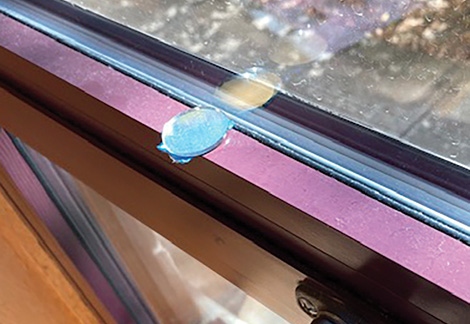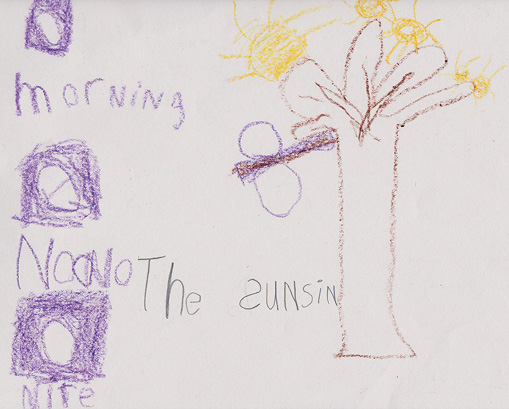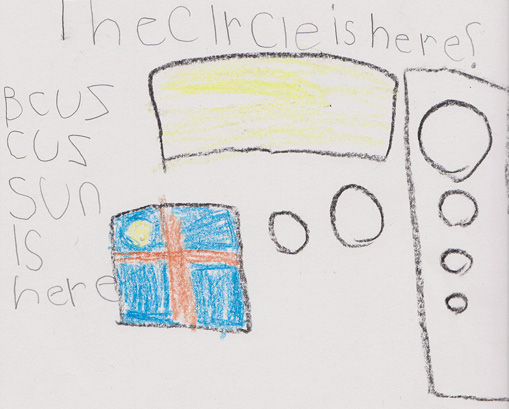feature
Sun Tracker
Kindergarten students explore the movement of the Sun with a simple classroom addition.
“It’s sunny today! We’ll be able to see it!” These kindergartners at Caldwell Heights Elementary School in Round Rock, Texas, were always excited about coming to school on days when the sky was clear and the morning Sun was shining.
Why? Because their classroom window faced south. But wait for the real reason for their excitement: As they burst into their room to start the day, they turned their faces not toward the window, but inward and upward…toward the classroom ceiling.
“There it is!”
“I saw it first!”
“Is it moving yet?”
The “it” on the ceiling was something they had named “The Light Circle”—a circular bright spot of light a few inches in diameter (Figure 1). What was it? How was it made?

The light circle.
At the beginning of the school year, we noticed the classroom window faced south. This meant the Sun would be shining into the classroom on clear days as it moved across the sky in its daily east-to-west path (see “Why a South-facing Window?”). How could we take advantage of our south-facing window to help these kindergarten scientists become aware of Sun movement patterns during the school year?
We decided to glue a small round mirror to the windowsill and watch what might happen (see Figure 2). We placed a premium on safety and cautioned children not to look at the Sun directly and not to look at it in the little mirror.


Mirror Setup
We found one-inch round mirrors sold in packs of 10 at our local craft store.
At the beginning of the school year, we waited for a sunny day and a time when the children were out of the room. Then we placed the mirror at several spots on the south-facing windowsill until we found the best location for sun dot visibility. (In rethinking this, we might set up the mirror with the children in the room next year. This would enable them to participate in the preparation process and have a sense of ownership from the start.)
We used a loop of sticky tape to fix the mirror in place and made sure to tell the custodian so that it would not be removed accidentally.
If you have curtains or blinds on your south-facing window, you might have to adjust their positions to allow passage for the sunbeams.
You might want to label the cardinal directions prominently in the classroom so that the children can refer to them accurately in their discussions.
That’s it! No moving parts. So simple.
Right away, the children noticed the reflection of the Sun on the ceiling. And then the questions started coming— and they never stopped! What makes it? Why is it round? Does it move? Why does it move? Why does it start over there in the morning? Where does it go on cloudy days? Over the weeks and months of this informal project, students found the answers to these and other questions as they observed, thought things through, and talked with each other.
The children immediately noticed that the Sun caused the dot on the ceiling. They proved this by blocking the reflected light from the mirror, causing the dot to disappear. After a few minutes, a couple of the children began looking puzzled. “I think the dot is moving.”“No, it isn’t!”After a few more minutes, the movement across the ceiling became clear to all. They were simply fascinated.
Why a South-facing Window?
The tilt of the Earth and the latitude of your location combine to determine if the Sun ever shines into your classroom window. For schools located north of the Tropic of Cancer (latitude 23.5 degrees north of the equator), the Sun is never high enough in the sky to shine into a north-facing window. East-facing windows enjoy only the morning Sun, and west-facing windows catch just the afternoon rays.
But the Sun shines into a south-facing window all day long, clouds notwithstanding.
(By the way, if you are planning to grow plants in your classroom, you will have the best chance of success with a south-facing window. But you probably already knew that!)
Note: If your school is in the Southern Hemisphere, then you would want a north-facing window for this project.
Observations
One of the first things the children wanted to do was to name the Sun dot. After much discussion, they settled on Light Circle. Totally descriptive. They marveled that their Light Circle traveled across the ceiling each sunny day. They connected this to the movement of the Sun across the sky from east to west. This daily pattern was very easy to detect.
As the autumn months passed, the children noticed the location of the Light Circle path changed. It got farther and farther away from the window. (The path was at its farthest distance from the window when the Sun was lowest in the sky—on December 21, at the winter solstice.) When they returned to school after the holidays, the children noticed the path began to move back toward the window (see Figure 3).

Seasonal differences.
One particularly observant child we’ll call Tracy started talking about the angle of the Sun and the height of the Sun in the sky: “The Sun shines down on the mirror and the light is reflected up to the ceiling. When the Sun is higher up in the sky, it makes a different angle to the mirror.” While this is not a typical kindergarten observation, children in higher grades would be able to see this pattern readily.
On rainy or cloudy days, the children clearly missed their bright classroom friend. Sometimes the sky would clear by afternoon, and they would find the Light Circle well along the way on its daily path. They all knew where their light friend would appear on the ceiling each morning and where it would be when it was time to go home.
On one particular sunny day, the children looked for the Light Circle when they returned to the classroom from the playground. It was nowhere to be seen! They were puzzled because it had always been visible on sunny days. Several of the children remembered where it was earlier. Irene said, “I think it was near the light,” meaning the fluorescent ceiling fixture, which happened to be on. Lyle said, “Maybe it is inside the light!” Bradley said, “Let’s turn the light off and see.” And sure enough! When we turned the light off, the Light Circle was there on the translucent panel. It had been washed out by the ceiling light itself.
After a couple months of observations, we asked the children to make drawings of their Light Circle. Several showed the relationship between the Sun, mirror, and reflection, and a few even showed the observed motion.
Children in higher grades could be asked to record their observations more systematically in journals or other record books, or perhaps by daily photographs at certain times of day. They could use ceiling tiles to estimate the distance traveled by the Light Circle over a period of time.
Also for higher grades, it is possible to generate the beautiful figure-eight analemma pattern (Lough and Vanover 2014; see also Internet Resources) by carefully and safely marking on the ceiling the location of the Sun dot at the same time each sunny day.


Students explained their thinking with illustrations.
In Conclusion
Kindergartners are curious about the world around them. They delight in finding new ideas and perspectives, especially those they can describe easily to others. Their Light Circle has generated a great deal of excited discussion among the children and among their family members. At a recent parents’ reading day, several moms and dads reported Light Circle conversations at home. One parent said, “My daughter has been so excited about this Sun dot. She tells us about it often at dinner—how it moves across the ceiling in the same direction each day. She is fascinated.“
Regardless of whether your school is open or not, the activity could also be implemented at home. Encourage each child’s family to find a south-facing window and affix a small mirror to the windowsill. That’s it.
The questions and comments of the children suggested that they were becoming more aware of the Sun in their universe. The project also acquainted them with some of the observable daily and yearly patterns, such as where the circle appears and disappears on sunny days. They began to anticipate and even predict the movement of the Light Circle.
Although space systems do not enter the Next Generation Science Standards (NGSS) sequence until first grade, this activity can generate curiosity and pave the way for a deeper understanding before the kindergartners move on up.
We invite readers with south-facing windows at all grade levels to affix a small mirror to the windowsill and enjoy the reactions of the students. But even if you don’t have a south-facing classroom window, maybe you could find another teacher who does. Or check your school for other rooms, such as the cafeteria (or the teacher workroom!), that might have a south-facing window. It will be well worth it, we guarantee! ●
Acknowledgments
Thanks to Caldwell Heights Elementary School teachers Sherrie Benhumea, Brett Carter, Diana Fitzpatrick, Evelyn Gonzalez, and Lynn Juhl for participating in an earlier version of this project, and to principal Michelle Montalvo for administrative support and encouragement.
References
Lough, T., and C. Vanover. 2014. Find your school’s analemma. Science and Children 52 (2): 55–59.
Adams, B. 2008. Here comes the Sun. Science and Children 46 (1): 56–58.
Hagan, P., and D. Ingram. 2004. Get sunwise. Science and Children 41 (9): 38–42.
Hemenway, M.K. 2000. Our star, the Sun. Science and Children 38 (1): 48–51.
Internet Resources
Tom Lough (mlough@murraystate.edu) retired from Murray State University in Murray, Kentucky, after 15 years as a science education professor. He now serves as a science education consultant in central Texas. Kim Hollifield (kimberly_hollifield@roundrockisd.org) is a kindergarten teacher at Caldwell Heights Elementary School in Round Rock, Texas.
Astronomy Earth & Space Science Inquiry Instructional Materials Early Childhood Grade K



